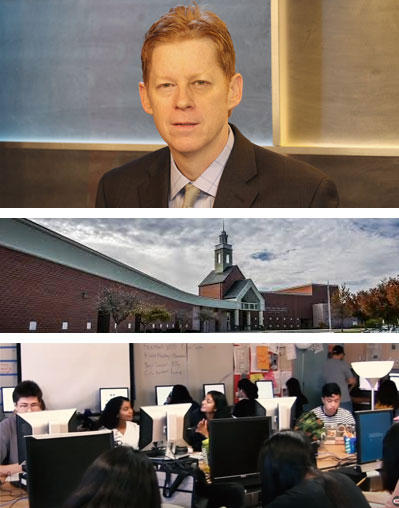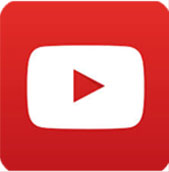
Teaching with StudentCam
Looking to engage your students with project-based learning?
Become a Faculty Adviser
Consider assigning StudentCam as a class project. This will require providing the time necessary for students to develop their documentaries, as well as monitoring their progress and providing guidance.
Below you will find ideas for introducing StudentCam to your students, as well as a rubric you can customize and use to evaluate their work.
In addition to the cash prizes awarded to the top 150 student-produced videos, the teacher advisers of our top 53 awarded videos will also receive prize money. For more information, visit our Prizes page.
Introduce the Competition as an Independent Project
Students can also complete their projects outside of class, and even submit them independently.
You are not required to be listed as a teacher adviser but if you provide critique or guidance along the way, and a student includes your contact information on their entry form, you are eligible to win the cash prizes that are reserved for the teacher advisers of the top 53 awarded videos.
LESSON PLAN: StudentCam Documentary Competition Step-by-Step Guide (C-SPAN Classroom)
Tips for Incorporating StudentCam in Your Classroom

George Mayo, a video production teacher at Montgomery Blair High School in Maryland and one of the most successful teacher advisers in the history of the competition, shared several documents that he uses to introduce StudentCam as a class project with his students.
In the videos below, several of his former students share how the steps in the Voter Guide and Research Outline documents helped them to plan and prepare for the production of their documentaries.
- Voter Guide Pamphlet Template (Google Doc)
- Research Outline Template (Google Docs)
George also shared two additional documents that he shares with students, including a template for a two-column script to help students plan their content and narration, as well a class rubric to define success for his students completing their projects.
- Two-Column Script (Google Doc)
- StudentCam Rubric (Google Doc)
01 – Voter Guide
- Voter Guide Pamphlet Directions (Google Doc)
- Voter Guide Pamphlet Template (Google Doc)
- Voter Guide Pamphlet Rubric (Google Doc)
- Student Examples: Example 1 | Example 2
02 – Research Outline
- Research Outline Directions (Google Doc)
- Research Outline Template (Google Docs)
- Student Example: Example 1
Additional Resources
Free B-Roll Footage
- 24 Websites to Find Affordable or Free B-Roll Footage (StudioBinder)
- Where to Find Free Cinematic B-Roll (Medium)
Free Video Editing Software
- The best free video editing software (CreativeBloq.com)
- WeVideo.com (Cloud-based Video Editing Platform)
- DaVinci Resolve (Cloud-based Video Editing Platform)
Fair Use Laws
- Documentary Filmmakers’ Best Practices in Fair Use (American University Center for Media and Social Impact)
How Long Will It Take To Make A Documentary?
Students should give themselves at least a few weeks to create their documentary. Below is a suggested time frame. Please keep in mind that many of these steps will overlap as students go through the process.
- Topic Selection and Initial Research: (1 week)
- Research and Scheduling Interviews: (2 weeks)
- Conducting Interviews & Shooting B-Roll: (2 weeks)
- Write your script: (1 week)
- Build your Rough Cut: (1 week)
– Edit interviews
– Find & download relevant C-SPAN clips
– Record Narration
– Add in music, transitions, text and title slides and credits - Polish Final Film & Submit to StudentCam: (1 week)
Frequently asked questions
Students may enter the competition individually, or work in teams of either 2 or 3 students. If an entry is awarded a prize in the competition, the money will be split evenly among team members. A single entry that is created by more than 3 students will be disqualified from prize contention.
Each student documentary MUST include the following five elements:
- A complete exploration of their chosen topic
- Inclusion of C-SPAN programming relating to their documentary’s topic (we recommend using several short video clips of C-SPAN programming)
- A balanced presentation of varying viewpoints (we recommend that students interview topic experts, elected officials and people directly impacted by their chosen topic)
- Adherence to the documentary time limit of 5:00 to 6:00 minutes. (End credits, if applicable, must begin after the minimum documentary duration of 5:00 minutes, but are permitted to run longer than the maximum documentary duration of 6:00 minutes)
- Credits at the end of their documentary or a works cited list
Student documentaries MAY include, but are not required to include:
- Additional video pertaining to their topic (B-roll footage)
- Music (preferably copyright free music)
- Graphics
- Diagrams
- Still images
- Narration (Note: If students narrate their documentary, they must write their own script to avoid plagiarism. They may use online or print sources to inform their narration, but they must put any information used in their own words.)
HOW LONG WILL IT TAKE STUDENTS TO MAKE A DOCUMENTARY?
We suggest students plan to dedicate several weeks to creating their documentary. Below is a suggested time frame for those who may wish to go above and beyond. Please keep in mind that several of these steps will overlap as students go through the process of producing their documentary.
- Topic Selection and Initial Research: (1 week)
- Research and Scheduling Interviews: (2 weeks)
- Conducting Interviews & Shooting B-Roll: (2 weeks)
- Write a Script: (1 week)
- Build a Rough Cut: (1 week)
– Edit interviews
– Find & download relevant C-SPAN clips
– Record Narration
– Add in music, transitions, text and title slides and credits - Share with friends and family and ask for their critique, make final edits and submit to StudentCam: (1 week)
Click here for a printable Student Checklist (Google Doc)
It is perfectly fine for students to use A.I. tools to brainstorm ideas and start to gather general information about their topic. Students should make sure to double-check the facts themselves and make sure that they put any information used in their own words unless they are directly quoting and citing sourced information.
We are most interested in your students’ own research and their presentation of the facts, opinions and stories related to their topic. Secondary consideration is given to the technical aspects of their work.
Students should not be paying money to download any C-SPAN footage for use in their StudentCam documentary.
Clips from many of the programs in C-SPAN’s extensive archives are available as FREE downloads in MP4 format on our C-SPAN Downloads page.
We recommend that students look for clips of C-SPAN programming that both support and oppose their own viewpoints. If students scroll down our Downloads page, they will see that we frequently update a large list of ready to download C-SPAN clips on a variety of topics that may be downloaded and used in their documentary.
If they don’t see their topic represented or need assistance downloading clips, they can simply email us at educate@c-span.org.
Another option perhaps worth exploring is using screen capture software. Many computers have screen capture software included in their pre-packaged software bundles. Other screen capture programs, like Camtasia, offer free trial periods lasting up to 30 days. Students can use the screen capture software in conjunction with C-SPAN’s streaming Video Library to capture C-SPAN video for use in their documentary.
If students have contacted C-SPAN’s Education team and they are still unable to download video, they may wish to stream video from C-SPAN’s Video Library, point their phone or video camera at the computer screen, and record the portion of the program that they would like to use. This may not result in the highest quality video, but it is always an option if students are pressed for time or unable to download the other provided options of C-SPAN video.
Remember to keep the camera steady (consider using a tripod if available), adjust the lighting, and check the recorded volume levels if students choose to capture video this way. This will ensure that students get the best quality video possible using this method.
There is no set time requirement for the C-SPAN clips used in any documentary but the inclusion of C-SPAN programming should be used to support and complement the overall presentation. We highly recommend that students review some of our past winning videos to get an idea of how they too can use short C-SPAN clips to provide additional perspective and enhance their documentary. We recommend that students consider using multiple short clips, but each individual C-SPAN clip used should be no longer than 15-20 seconds. If using multiple C-SPAN clips students may choose to stagger them intermittently throughout their documentary, or have several short clips play consecutively in a row.
C-SPAN produced programming is copyright cleared for use in educational applications like StudentCam. Students may use clips from any of our programs in their documentary, including C-SPAN’s programs like Washington Journal, American History TV and BookTV.
C-SPAN’s philosophy is to always show multiple perspectives and points of view on any issue that we cover as a television network. Students should treat their documentary in a similar fashion, providing comprehensive overview of their topic and an exploration of the differing points of view, including those that they may personally disagree with.
If students are comfortable sharing their own point of view about their chosen issue, they are welcome to do so. Students may also consider sharing at some point during their production whether their views have changed or solidified through out the process of researching their documentary.
In order to present varying opinions about their documentary’s issue, students may also want to interview people who have differing points of view on their chosen issue. Students may also choose to explore how their issue may affect different groups of people in different ways.
Another way students can show varying points of view on their topic is through the use of clips from C-SPAN, showing various officials and experts with juxtaposing viewpoints.
There are no requirements for who should be interviewed in their documentary but we strongly encourage students to consider interviewing experts on their chosen topic, as well as local and national political leaders. They may consider interviewing people who have been impacted by the topic that they are researching, as well as people who work in related fields. They may also choose to interview activists, university professors, historians, and local, state and federal officials who may be involved in related legislation and policy.
The goal is to provide a well-rounded look at their chosen topic so ask them to consider interviewing people who may have alternative points of view.
We suggest contacting potential interview subjects (or their assistants) via phone or email. Students may also consider using social media sites like Twitter or LinkedIn to request a short interview. We recommend that students cast a wide net and be persistent when soliciting interviews. It never hurts to ask and students may be surprised by who is willing to sit down with them for an interview! The interviews will often add credibility to their work and is a clear way to help set their work apart from other documentaries in the competition.
Students may also want to consider searching their topic in C-SPAN’s video library to see who has appeared on our network before and spoken about their issue. Student could then mention that they have seen that person on C-SPAN before, and that they are working on a documentary for C-SPAN’s StudentCam competition. Students can search our archives here: https://www.c-span.org/search
When contacting potential interview subjects, consider sharing this document with them which provides an overview of the competition:
StudentCam Competition Overview. (Google Doc)
A majority of students simply use their cell phones or tablets to produce their StudentCam documentaries.
Alternatively (or in addition to), if there are video cameras and/or editing equipment available at the school or in the library, consider providing access to your students.
If students are unable to use their phones or school equipment, they can also try contacting public libraries in your area to see if they may have equipment to lend to students.
They can also try their local cable affiliate, local television stations or local public access channel.
With all of that said, many cell phones and digital cameras are able to record video of increasingly high quality. There are also many free video editing apps that are available for smartphones and devices that are worth exploring.
Judging will take place in C-SPAN’s offices in Washington, DC from January through March.
As an amateur video competition, the judges’ strongest critiques center primarily on the content, research, and presentation of each documentary. We are most interested in the students’ original work and the presentation of information within their documentary. Secondary consideration is given to the technical aspects like editing and video quality. While the technical aspects of their video are important, we also realize that this may be the first time many students have created a video, and that their access to technology may be limited. We encourage all students to participate regardless of past filmmaking experience and it is important to note that numerous top prize winning videos each year are made by students with no prior video editing experience.
Entries will be judged on the following criteria:
- Complete exploration of the chosen topic, and its relation to the contest’s theme
- Quality of expression and student creativity
- Inclusion of topically relevant C-SPAN programming
- Thorough exploration of the varying points related to the chosen topic (including opposing viewpoints, where applicable)
Entries must be uploaded by 11:59pm Pacific Standard Time at the end of the day on January 20, 2026.
Once students have completed their video, they must first upload it to a video host such as YouTube, Google Drive, DropBox or WeVideo.
They then copy and paste the link for us to view and judge their video when they submit the Entry Form, linked on the StudentCam homepage.
**PLEASE NOTE:** The students’ video must be either marked as “Unlisted” or “Public” on YouTube, or marked as “Anyone who has the link can view” in Google Drive. Videos that are marked “Private” on any platform will not be able to be viewed or judged by C-SPAN staff. If students are using a school district Google account, please ensure that those videos can be viewed by accounts that are outside of your school district.
Students DO NOT need to provide any prior notice of their intention to enter.
The only requirement is that their video and Entry Form is submitted online by the deadline, which is 11:59pm Pacific Standard Time at the end of the day on January 20, 2026.
The 150 winning videos will be announced on the StudentCam website in March 2026. Winning students and teachers will be notified via email.
If you have further questions, please contact C-SPAN’s Education team at educate@c-span.org or call our Washington, DC office at 202-626-4858 between 9:00am-4:00pm ET.
Common Core State Standards in ELA
The video contest is closely aligned to the Common Core State Standards in ELA. It meets the following Standards:
- CCSS.ELA-Literacy.CCRA.R.2 Determine central ideas or themes of a text and analyze their development; summarize the key supporting details and ideas.
- CCSS.ELA-Literacy.CCRA.R.7 Integrate and evaluate content presented in diverse media and formats, including visually and quantitatively, as well as in words.
- CCSS.ELA-Literacy.CCRA.W.2 Write informative/explanatory texts to examine and convey complex ideas and information clearly and accurately through the effective selection, organization, and analysis of content.
- CCSS.ELA-Literacy.CCRA.W.4 Produce clear and coherent writing in which the development, organization, and style are appropriate to task, purpose, and audience.
- CCSS.ELA-Literacy.CCRA.W.6 Use technology, including the Internet, to produce and publish writing and to interact and collaborate with others.
- CCSS.ELA-Literacy.CCRA.W.8 Gather relevant information from multiple print and digital sources, assess the credibility and accuracy of each source, and integrate the information while avoiding plagiarism.
- CCSS.ELA-Literacy.CCRA.SL.1 Prepare for and participate effectively in a range of conversations and collaborations with diverse partners, building on others’ ideas and expressing their own clearly and persuasively.
- CCSS.ELA-Literacy.CCRA.SL.2 Integrate and evaluate information presented in diverse media and formats, including visually, quantitatively, and orally.
- CCSS.ELA-Literacy.CCRA.SL.4 Present information, findings, and supporting evidence such that listeners can follow the line of reasoning and the organization, development, and style are appropriate to task, purpose, and audience.
- CCSS.ELA-Literacy.CCRA.SL.5 Make strategic use of digital media and visual displays of data to express information and enhance understanding of presentations.
- CCSS.ELA-Literacy.CCRA.SL.6 Adapt speech to a variety of contexts and communicative tasks, demonstrating command of formal English when indicated or appropriate.
- CCSS.ELA-Literacy.CCRA.L.6 Acquire and use accurately a range of general academic and domain-specific words and phrases sufficient for reading, writing, speaking, and listening at the college and career readiness level; demonstrate independence in gathering vocabulary knowledge when encountering an unknown term important to comprehension or expression.



